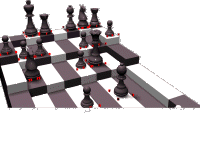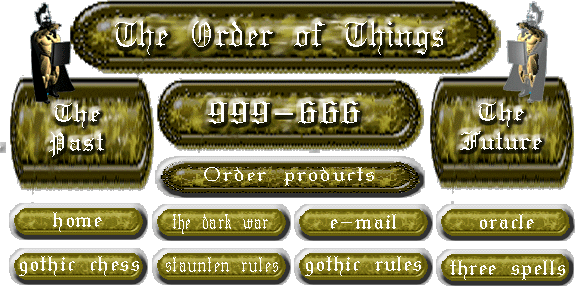|
|
|



The word Gothic means: to build outward and upward. Gothic Chess is a board game that closely resembles a typical chess game. The names of each player, their positions and their moves are the same, however, the playing board, or Life Board, is divided into seven different playing surfaces, called Battle Boards. Four descending levels representing, Hope, Health, Hunger, and Pain,. These levels can appear distorted, depending on the placement of each game piece within that Battle Board. Each colored space or Battle Block is sized according to the ranking file. The lowest level of the Life Board is the largest and most often used, to distort the typical perspective of a standard chess pattern. As with standard chess, control of the center of the board, gives a distinct advantage. Control of the Pain Board is control of the perspective view that you and your opponent will see.
A not so hidden story line, that explains the moves and strategies of typical chess, is used to make learning the game easier.
The introduction of removable base guides show the possible attack profiles of each player. The most often asked question by a beginner or novice chess player is about how the players move. Learning the game
becomes easier than typical chess as the base guides give visual clues
about the attack and defense capabilities created by the game play. An experienced chess player can play with a distinctive handicap
, by keeping his base guides in place and removing the
novice or beginners base guides. The beginner can more easily see the attack
coming and defend accordingly. Learning the moves of the players no longer requires the pupil to use memory.
The flat two dimensional training board, the
Dragonknave board, is designed to prepare a window
for the players to deal with curved lines of attack and defense.
Learning the game
becomes easier than typical chess as the base guides give visual clues
about the attack and defense capabilities created by the game play. An experienced chess player can play with a distinctive handicap
, by keeping his base guides in place and removing the
novice or beginners base guides. The beginner can more easily see the attack
coming and defend accordingly. Learning the moves of the players no longer requires the pupil to use memory.
The flat two dimensional training board, the
Dragonknave board, is designed to prepare a window
for the players to deal with curved lines of attack and defense. This board is sold
separately or is included as the foundation of the Gothic life board. Uneven
battle on the three dimensional life board, is recommended only for those who
have mastered the knaveboard and bridged the gap of ignorance. There are twelve
stackable books to use as checkers, representing the twelve past conflicts
between Dragon and Bane. By design, knave and novice players must first learn to
read the angles and then apply that past time, to the real game of kings.
This board is sold
separately or is included as the foundation of the Gothic life board. Uneven
battle on the three dimensional life board, is recommended only for those who
have mastered the knaveboard and bridged the gap of ignorance. There are twelve
stackable books to use as checkers, representing the twelve past conflicts
between Dragon and Bane. By design, knave and novice players must first learn to
read the angles and then apply that past time, to the real game of kings.

The story all began with peace between two kings. Dragon and Bane, both equals in status, were bragging and comparing their rules and their armies. Whether it was a drunken knight or pawn that started the war, is not important, the fact that their king would defend them at all cost, is! The Book of Gothic Chess may in fact be, a historical record of this conflict.
Starting the game:
The armies themselves are distinctively different, but if a choice of which side to take occurs, then an equal chance contest must be used to designate ruler of Dragon (dark) or Bane (light) game pieces.
Each team takes turns strategically placing his army in such a way as to defeat the opponent, by capturing the King piece.
Bane (light) game pieces make the first move in the game and must be committed by a pawn or knight. A knight is the only player capable of unobstructed movement, this is explained in the Game pieces and Descriptions section of this plan. A pawn’s first move off of his starting position is optional, your choice to move one or two Battle Blocks forward.
When a player’s piece is moved onto any Battle Block, that block is considered captured. Any opponent game piece already in that space is defeated.
Defending a Battle Block, requires you to place a game piece in a position capable of capturing that block, in your next move.
A player’s piece can not pass through any other piece to get to the blocks behind it, only the knight game piece has this ability and flaw.
Sacrifice is a part of life and if you can exchange a lower status game piece for a higher status game piece, then it is a price to pay but a profit to be made.
Use player combinations and multi-level attacks to confine and capture the opponent’s king, or any other worthwhile game piece. Planning any maneuver of your forces should have consideration for at least three moves ahead, to be of scale with most average players.
When a king is in line with an opponents attack, he is considered to be in a check position: a defensive player must be put between the king and his attacker, or the attacker must be eliminated. The King can move to a safe block, but it is not advised to move the King unless capture is imminent. If a King has been moved from his original starting square, no King Castle Guard maneuver may be used: this is explained in the Three Spells section of this plan.
Capturing the King piece is the end of the
game, an honorable surrender may be offered at any time throughout the game, by
placing the King piece face down on the Pain Board.
Stalemate or Vanishing is a rarely seen ending
to a contest. Some games will have no winner, this is explained in the
Three Spells section.

